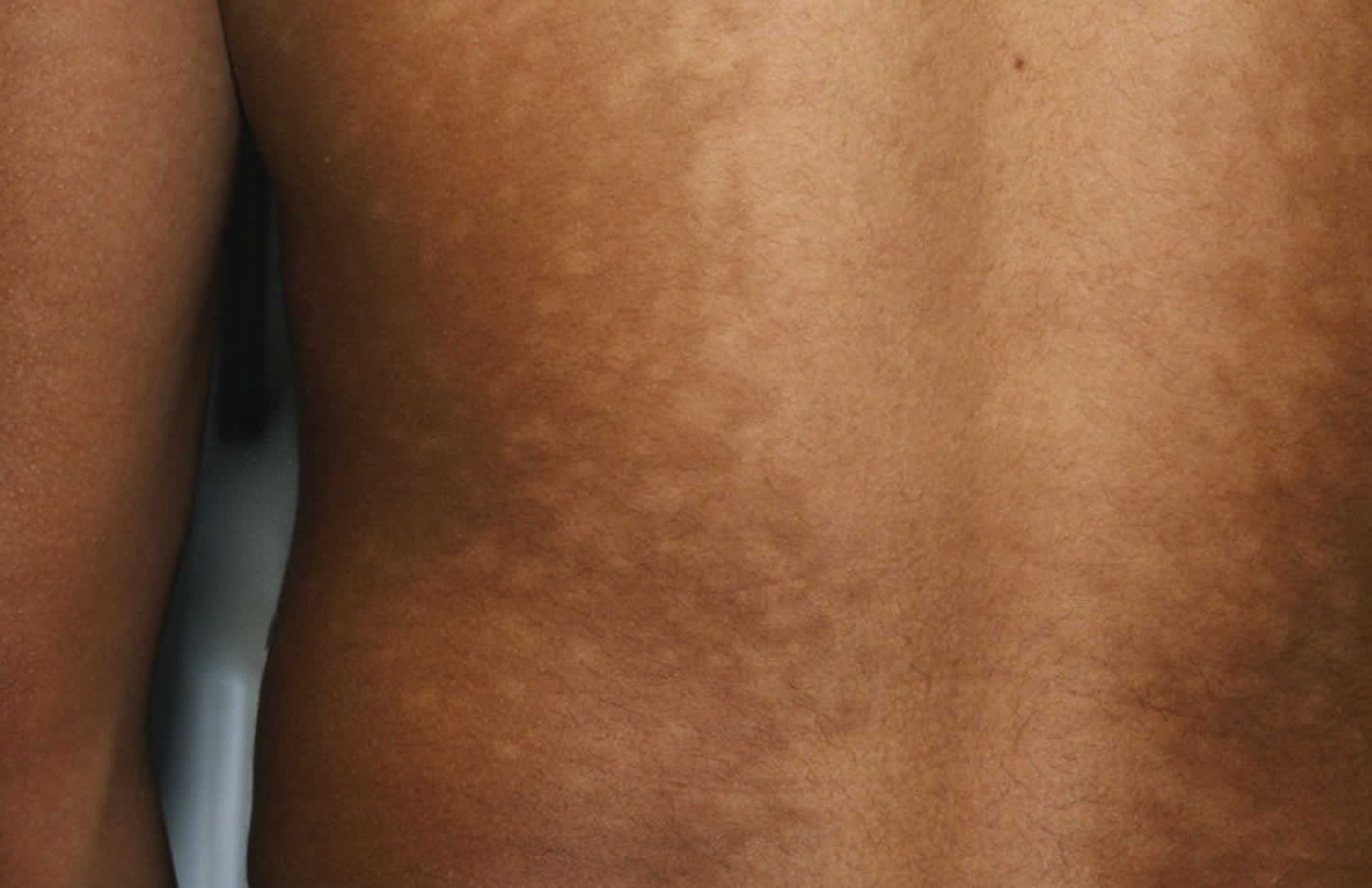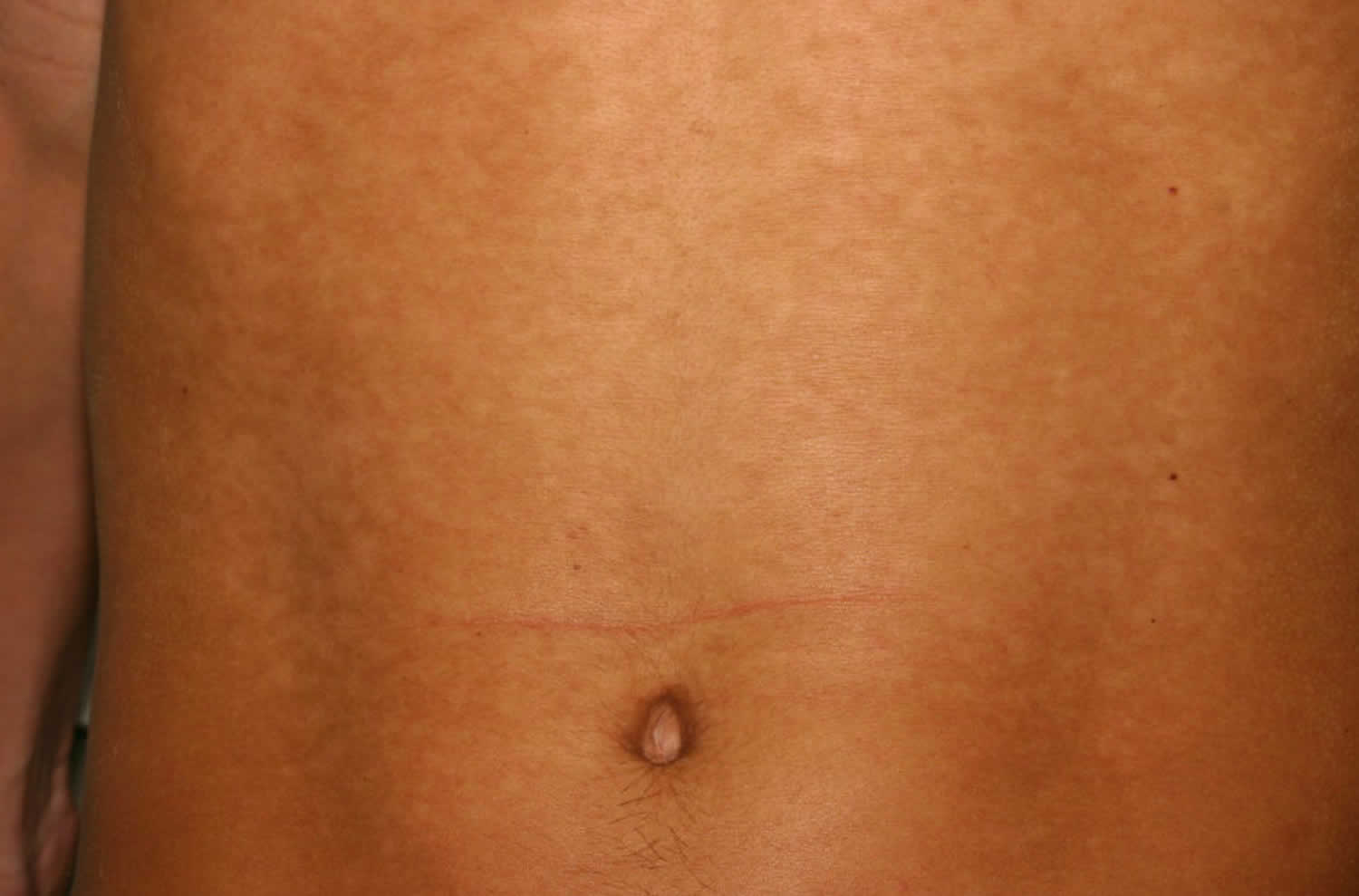Progressive macular hypomelanosis
Progressive macular hypomelanosis is a fairly common skin condition where there are circular areas of nonscaly hypopigmented macules mostly located in the sebaceous areas of the trunk, often confluent in and around the midline, and rarely extending to the proximal extremities and neck/head region 1. There is no inflammation, pain, or itching associated with progressive macular hypomelanosis, but the disease can have a major psychosocial effect on patients. Progressive macular hypomelanosis affects teenagers and adults worldwide. Progressive macular hypomelanosis is more common in people of darker skin color that light skin color, and may be more common in women than in men 2. Progressive macular hypomelanosis should be differentiated from other disorders with hypopigmentation on the trunk such as pityriasis versicolor.
Progressive macular hypomelanosis is characterized by ill-defined nummular, non-scaly hypopigmented spots on the trunk. There is no itch, pain, or preceding inflammation. progressive macular hypomelanosis has a worldwide distribution; however, it is more often identified in Black people living in or originating from tropical countries.
The course of progressive macular hypomelanosis is reported to be variable. Some cases may resolve in 3–5 years. Others remain stable and yet others progress over decades and may then resolve in middle age. It is not possible to predict spontaneous recovery based on clinical or demographic characteristics.
There is no widely accepted first-line treatment for progressive macular hypomelanosis. Several treatment modalities are used against progressive macular hypomelanosis including topical benzoylperoxide 5% and clindamycin 1% alone or in combination with ultraviolet A (UVA) or narrow band ultraviolet B (UVB) irradiation 3, oral lymecycline in combination with topical benzoylperoxide 5% for 3 months 4 and low-dose isotretinoin for 1 month 5; however, the ideal treatment is not yet defined.
Figure 1. Progressive macular hypomelanosis
Progressive macular hypomelanosis cause
The cause of progressive macular hypomelanosis is not known. The acne Gram-positive anaerobic bacterium, Cutibacterium acnes (formerly Propionibacterium acnes), have been found in hair follicles of hypopigmented areas and may cause the loss of color 6. However, these bacteria have not been found in all patients with progressive macular hypomelanosis. Genetic factors are also thought to be important.
Progressive macular hypomelanosis symptoms
Progressive macular hypomelanosis mainly affects the trunk, rarely extending to the arms, legs and/or neck. There are multiple, circular, poorly defined pale and non-scaly spots that merge together.
The patches are not scaly, unlike hypopigmented pityriasis versicolor, which can also cause pale patches on the trunk. They are not preceded by inflammation, unlike postinflammatory hypopigmentation following nummular eczema or psoriasis.
Progressive macular hypomelanosis diagnosis
Progressive macular hypomelanosis is usually diagnosed based on history, clinical features and supported by the presence of red follicular fluorescence on Wood’s lamp examination and seldom a skin biopsy. The hair follicles fluoresce with a red glow, indicating they are colonized by Cutibacterium acnes (formerly Propionibacterium acnes).
Microscopic examination of a skin biopsy shows a reduction in melanin in the the affected skin, with normal numbers of melanocytes (specialized pigment cells that produce melanin). On electron microscopy of affected areas, the melanosomes (the granules that store melanin in the cell) are smaller and aggregated, compared to surrounding skin.
Progressive macular hypomelanosis treatment
The treatment of progressive macular hypomelanosis is challenging and oftentimes delayed, which can be particularly disappointing in those with skin of color in which dyschromia is significantly more evident. There is no first line or single effective treatment for progressive macular hypomelanosis 7.
Treatments for progressive macular hypomelanosis include:
- Narrowband UVB phototherapy 8
- Oral tetracyclines 9
- Topical anti-acne preparations eg clindamycin 1%, and benzoyl peroxide 5% 10
- Combination treatments.
Isotretinoin was effective in one case report 11.
Progressive macular hypomelanosis may relapse following treatment.
References- Petersen RL, Scholz CF, Jensen A, Brüggemann H, Lomholt HB. Propionibacterium Acnes Phylogenetic Type III is Associated with Progressive Macular Hypomelanosis. Eur J Microbiol Immunol (Bp). 2017;7(1):37-45. Published 2017 Feb 27. doi:10.1556/1886.2016.00040 https://www.ncbi.nlm.nih.gov/pmc/articles/PMC5372479
- Relyveld GN, Menke HE, Westerhof W. Progressive macular hypomelanosis: an overview. Am J Clin Dermatol. 2007;8(1):13-9. doi: 10.2165/00128071-200708010-00002
- Kim MB, Kim GW, Cho HH, Park HJ, Kim HS, Kim SH, Kim BS, Ko HC. Narrowband UVB treatment of progressive macular hypomelanosis. J Am Acad Dermatol. 2012 Apr;66(4):598-605. doi: 10.1016/j.jaad.2011.04.010
- Cavalcanti SM, Querino MC, Magalhães V, França ER, Magalhães M, Alencar E. The use of lymecycline and benzoyl peroxide for the treatment of progressive macular hypomelanosis: a prospective study. An Bras Dermatol. 2011 Jul-Aug;86(4):813-4. English, Portuguese. doi: 10.1590/s0365-05962011000400034
- Kim YJ, Lee DY, Lee JY, Yoon TY. Progressive macular hypomelanosis showing excellent response to oral isotretinoin. J Dermatol. 2012 Nov;39(11):937-8. doi: 10.1111/j.1346-8138.2012.01605.x
- Magalhães M, de Alencar ER, Magalhães V. Investigation of Propionibacterium acnes in progressive macular hypomelanosis using real-time PCR and culture. Int J Dermatol. 2011 Nov;50(11):1347-52. doi: 10.1111/j.1365-4632.2011.04978.x
- Buainain de Castro Maymone, Mayra & Vashi, Neelam. (2016). Progressive Macular Hypomelanosis. 10.1007/978-3-319-22392-6_18.
- Fluhr JW, Gloor M. The antimicrobial effect of narrow-band UVB (313 nm) and UVA1 (345-440 nm) radiation in vitro. Photodermatol Photoimmunol Photomed 1997;13:197-201.
- Elmariah SB, Kundu RV. Progressive macular hypomelanosis. J Drugs Dermatol 2011;10:502-6.
- Santos JB, Almeida OL, Silva LM, Barreto ER. Efficacy of topical combination of benzoyl peroxide 5% and clindamycin 1% for the treatment of progressive macular hypomelanosis: A randomized, doubleblind, placebo-controlled trial. An Bras Dermatol 2011;86:50-4.
- Kim YJ, Lee DY, Lee JY, Yoon TY. Progressive macular hypomelanosis showing excellent response to oral isotretinoin. J Dermatol 2012;39:937-8.






